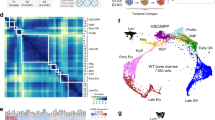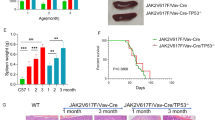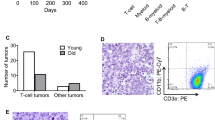Abstract
We have previously developed an in vivo model of leukemogenesis utilizing mice reconstituted with genetically modified bone marrow cells. Based on those studies, a new single gene retroviral vector has been engineered which efficiently transfers v-myc into immature murine bone marrow cells. All reconstituted mice developed leukemia with a short latency period (5–11 weeks). In addition to hyperproliferation associated with elevated levels of PCNA, extensive apoptosis was also observed in all leukemic animals with p53 accumulating in the apoptotic cells. Whereas bax encoded protein, an effector of p53 apoptotic activity was detected in apoptotic cells, p21Waf1 protein, a potential mediator of p53 growth suppression was not detected in these cells suggesting that v-myc-induced apoptosis was independent of the ability of p53 to induce p21Waf1. These results indicate that apoptosis, a part of the cellular response to v-myc expression, does not prevent leukemia development and that hyperproliferation rather than abrogation of oncogene-induced apoptosis appears to be a critical event in v-myc-induced leukemia.
This is a preview of subscription content, access via your institution
Access options
Subscribe to this journal
Receive 12 print issues and online access
$259.00 per year
only $21.58 per issue
Buy this article
- Purchase on SpringerLink
- Instant access to full article PDF
Prices may be subject to local taxes which are calculated during checkout
Similar content being viewed by others
Author information
Authors and Affiliations
Rights and permissions
About this article
Cite this article
Dolnikov, A., Shounan, Y., Millington, M. et al. V-myc in a simple, single gene retroviral vector causes rapid induction of leukemia and concomitant apoptosis following bone marrow transplantation. Leukemia 12, 542–553 (1998). https://doi.org/10.1038/sj.leu.2400968
Received:
Accepted:
Published:
Issue date:
DOI: https://doi.org/10.1038/sj.leu.2400968
Keywords
This article is cited by
-
The v-myc oncogene
Oncogene (1999)



